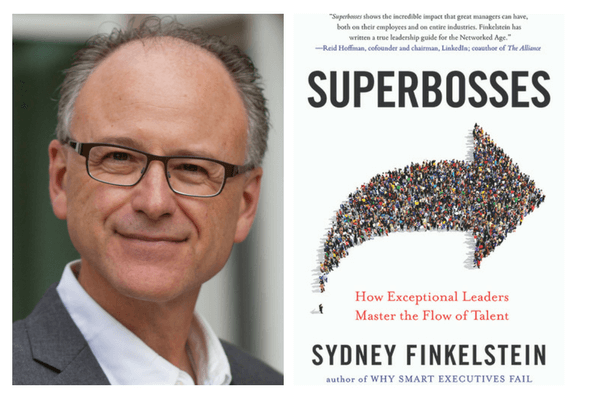
Author and leadership guru Sydney Finkelstein defines a “superboss” as someone unusually skilled at identifying and developing talent. Superbosses spawn a network of talent within organizations and entire industries. The eighteen exceptional leaders Finkelstein describes in Superbosses, a book based on a decade of research, include fashion mogul Ralph Lauren, marketing maven Jay Chiat, technology empire-builder Larry Ellison, NFL coaching legend Bill Walsh, and more.
Superbosses find talent in unconventional places, developing people with a hands-on, master-apprentice approach, and sparking innovations that create new business opportunities. As Finkelstein explains: “Superbosses yield a fresh set of answers, practices that anyone can borrow to nurture others and create an inexhaustible pipeline of rising stars.” We spoke with him about how middle market companies can learn from “the superboss playbook” to foster talent.
How might the superboss playbook be applicable for middle market companies?
The superboss playbook applies to any type of leader in any organization that needs to build leaders, so that’s all organizations. In a middle market company, you might easily argue, superbosses have a greater potential impact to move the needle. In a big company, there are just so many structures and processes and bureaucracies that make change harder.
Because of their more manageable size compared to giants like GE or Google, middle market companies have a real opportunity to inculcate the DNA of the superboss culture. They can thus gain a competitive advantage over huge companies that normally have an edge over them due to scale, because middle market companies can more easily create a culture of talent using the superboss playbook.
Can you explain how superbosses think differently about talent retention?
Superbosses are radical in many ways, and here’s one of them. If you find and develop great people, they will receive great opportunities. The best thing any middle market company can do is grow their business in order to create more opportunities for talent, so that bigger companies can’t come in and poach your talent. Now how do you grow? Develop the best talent, of course. So building a company of superbosses is the best way to grow any business.
But sometimes, you won’t grow fast enough or the outside opportunity is just too attractive. At that point, your choice is to be strategic and get some benefit from the situation. The talent gets to choose, and if you’re a great talent scout, then you already have a pipeline of talent ready to replace the one you’re losing. If you’ve helped someone develop and that’s led them to a big career opportunity, they’ll keep looking for opportunities to work with you and help you out in the future. You thus create a network of talent both inside and outside your company.
How might middle market leaders leverage the superboss playbook to attract talent in the first place?
All leaders have to be talent scouts. No matter where you go, even if you’re not currently hiring, keep your eyes open for talent. Don’t be afraid to hire somebody on the spot. Superbosses take chances on unconventional candidates.
Some of this is about culture, and it gets established from the top. How do the CEO and senior leadership support hiring people with unconventional backgrounds? The way to deal with eliminating obstacles [to hiring talent from unusual backgrounds] is by getting buy-in from the CEO, founder, and senior executives.
How can middle market companies follow the superboss playbook to engage talent?
In a middle market company, every employee counts. You can’t afford to have any “dead-weight” at all. The superboss playbook allows every single person to count. Superbosses unleash the creativity of the people around them, because superbosses expect to hear your best ideas on a regular basis. This is highly motivating: you’re creating an environment where each leader is seeking to learn and benefit from all the people around them.
How can would-be middle market superbosses develop teams?
“Superbosses” discusses the “cohort idea.” It’s about collaboration and competition. If you put together a team of talent, they will get better all by themselves when you simply create an environment of high expectations and they start looking around at each other, independent of what a superboss might do.
You need to find the right balance between collaboration and competition. You don’t want teams competing with each other in a cut-throat way, because people start protecting themselves, hoarding information, and stop acting like team players. But if all you ever do is collaborate, and there’s no edge there, you don’t get the best out of people either. So actively thinking about how to get this balance right is the magic spot where you want to be.
How can middle market companies better understand their customers by using the superboss playbook?
Superbosses get out of their offices. Often, their office is in the center of a room where there’s constant information flow. Superbosses meet customers all the time, they talk constantly to employees who aren’t just direct reports but who are two-levels or more down. They go with team members to visit clients.
During research for the book, I heard a story about a middle market salesperson going on a big sales call to New York City. When she’s checking in at the prospect’s security desk, her CEO was waiting there for her, completely unannounced. He wasn’t there to take over her pitch but to act as her wingman, to support her and give feedback along the way. Not only did that middle market CEO help develop that particular salesperson, but he gained valuable insights about his market and clients in doing so. Superbosses roll up their sleeves, but don’t micromanage.
To assess whether you’re a “superboss,” you can take this quiz. For more information about implementing the “superboss playbook” inside your organization, visit here.